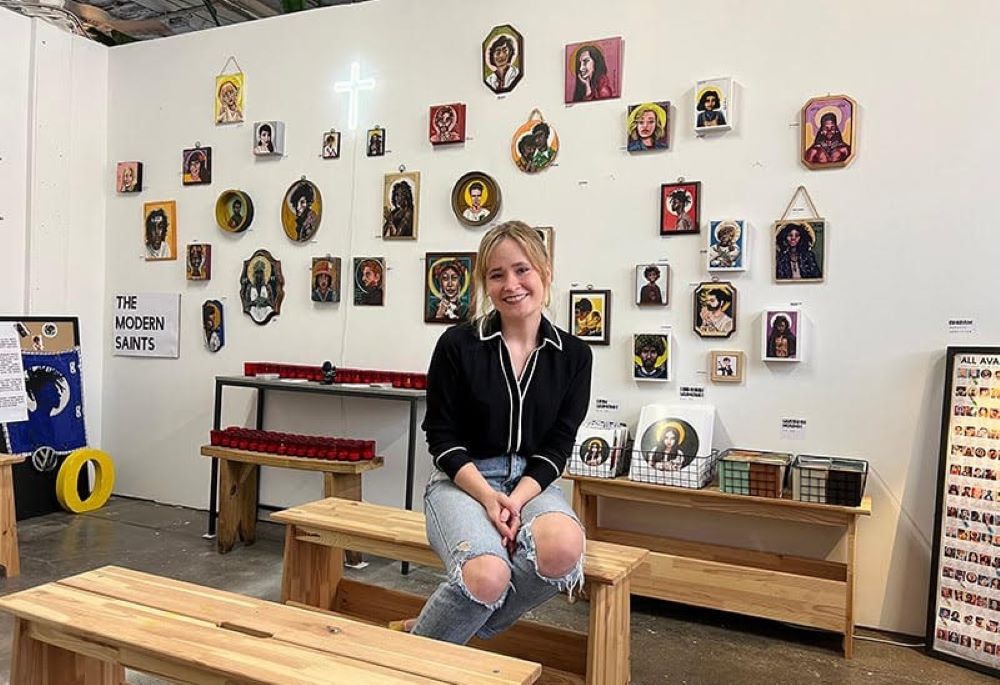
Gracie Morbitzer, artist and editor behind the new book "Modern Saints: Portraits and Reflections on the Saints," poses in her studio. "I think it's important to see these people looking like us because that brings home the idea that we all have the chance to be a saint," Morbitzer said. (Courtesy of Gracie Morbitzer)
The Modern Saints: Portraits and Reflections on the Saints is a breath of fresh air.
In this new book, rich portraits by artist Gracie Morbitzer are coupled with spiritual reflections from diverse contributors — including Marcie Alvis Walker, Jesuit Fr. James Martin, Tsh Oxenreider, Christena Cleveland and others — to connect modern readers to the lives of the saints and create a sense of belonging within the universal church.
I recently sat down with Morbitzer to interview her about this extraordinary work. The following conversation has been edited for length and clarity.

NCR: Can you share a little about your background, both spiritually as well as artistically?
Morbitzer: I grew up going to Catholic school in Columbus, Ohio. Both sides of my family descended from German immigrants. I had a family that was very devoted to making sure that I had a really good education in both the Catholic religion but also academically. I always felt like my personal spirituality was a little bit different than a lot of my peers' and family members'. I felt a little separated from them but didn't quite know why.
When I graduated, I went to Columbus College of Art & Design. Though my parents were creative and supported me going to art school, I experienced resistance from friends and classmates who were wary of how progressive art school would be. It's small and there's no faith-based groups. I was excited to see how that would be and hear from all these different students and their different perspectives.
What inspired you to start painting the saints? Which saint was your first?
When I worked as an RA, other students who grew up with religion would tell me about all of the hurt they went through, which hadn't been my experience. But it made me realize how much of a problem it was. Their stories reminded me of some of the saints who had been hurt by people in the name of Christianity, who were disbelieved or cast out for their ideas that were different than what was popular at the time, even if it's different than what the church believes now.
I hope to share the message that if they still want to have a place in the church, they can and do — and we have these role models who have come before us, who have shown us that there's not only one way to be a Christian. We can all use whatever different talents and skills and passions we have. I thought the best way to do this was through creativity.
The project really started accidentally. I found two free pieces of wood at a yard sale and they reminded me of pieces that icons had been painted on traditionally. And even though I knew nothing about iconography at that point, I decided to create two pieces for my dorm room. I painted Jesus in a white T-shirt, and the longer that I sat with it I realized that was pretty powerful itself. You know, seeing Jesus look like one of the students that I worked with or someone that I might walk outside and see. The second one I painted was Mary. I only found out later, after more research and study on iconography, that those are the two you're supposed to start with. I thought that was a pretty good coincidence. Then I found a cool piece of wood at a thrift store and decided to paint my patron, Genevieve, after that.
Why opt for a modern style?
When I posted those first icons on social media, saint portrait requests started coming in from Catholic school friends; that's how it started. Then at an art fair, the person in the booth across from me had blue hair, and I noticed they kept looking at my icon of St. Joan of Arc, whom I depicted with blue hair. I think it's important to see these people looking like us because that brings home the idea that we all have the chance to be a saint.
Gracie Morbitze created this icon of St. Mark Ji Tianxiang, a Chinese Catholic layman, doctor and former opioid addict who was martyred during the Boxer Rebellion. (Courtesy of Gracie Morbitzer)
Have you experienced any challenges within the church, or concerns about your depictions?
Oh, definitely. I'm "too religious" in secular spaces and I'm "too secular" in religious spaces. But if I didn't have anyone who felt strongly against what I'm doing, I also wouldn't have anyone feel strongly for what I'm doing. I get a lot of comments about not being a traditional iconographer, which I'm not trying not to claim. Iconography has very specific rules and training, and that's not what I'm trying to do. I use the rules that I do know, and break some of them consciously, while still following as many as I can.
You depict these saints in a very conscious way. Even if you change their hair color or give them tattoos or piercings, you seem committed to preserving their ethnicity and race.
Yes, before I begin I do a lot of research and find reference images of people who live in the area today and I incorporate those. A lot of traditional icons that have survived were made by European monks who whitewashed the saints' features, either because they lived in a monastery and had never seen anyone that didn't look like them or because they were consciously creating something they could best relate to. Which is the same thing I do; I just don't believe changing the subject's ethnicity is the way, because it erases their identity and part of their story. Correcting that with this project is important to me.
What inspired you to compile the book and to reach out to contributing writers for reflections?
I've always loved saint dictionaries, and so that's the format that we wanted to go with. Since the goal is to think about the saints in our current context, we decided it would be good to include a reflection about what they would be doing today, what wisdom or goals they had and why they are still important today.
I started writing these myself, but there are 52 saints in the book and by the fifth I realized I was not equipped to write them all. And if the goal is to show how different their voices were, and how different their goals and skills and interests were, then why not have the reflections written by people with different goals, skills and wisdom, from different backgrounds and perspectives just like these saints?
Advertisement
Do you continue to feel vigor or do you ever get bored? How do you continue in your creative practice?
I can't say I've ever gotten bored with it. I get messages from people about saints they have a strong connection to, and when I research that new saint I get interested, too. I love history and research and the stories of people, which is probably why I've always been drawn to the saints. Each new project is new and I love the challenge of taking on each story.
What words of wisdom would you give to other young or new artists trying to find their preferred medium or artistic voice?
Be authentic to who you are, what you're interested in and what inspires you. The people who will be most impacted will eventually find you, and then they'll be around forever.
Is there anything else you'd like to share about your book?
The thing about this book is that whatever belief you hold and want to confirm, you can probably find; but at the same time, you will probably also find an idea that will challenge you. My hope is that the reader gets inspired by some new saints, and that they see how varied, interesting and deep this faith can be.





